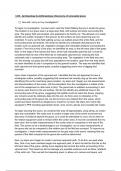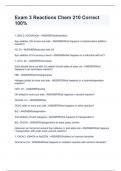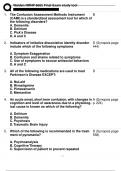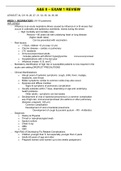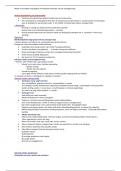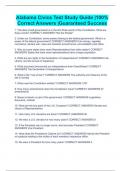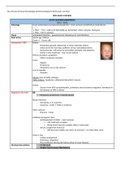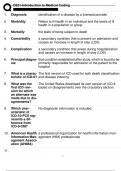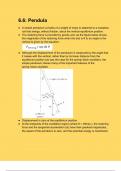14 B - Archaeology & Anthropology: Discovery of concealed grave
How did I carry out my investigation?
To begin my investigation, my team and I used the Field Walking Survey to locate the grave.
The location of our grave was in a large open field, with bushes and trees surrounding the
area. The grassy field was levelled, and appeared to be freshly cut. This allowed us to easily
identify any sudden changes in the ground, as the surface we were observing was not
restricted. To carry out the field walking survey, we walked around the entire field, and the
surrounding trees and bushes. We aimed to identify any noticeable disturbances to the
location such as upturned soil, vegetation changes and noticeable artefacts surrounding the
location. From this survey of the area, we identified an area, to the left hand side of the grass
field, on the edge of the bushes and trees, which had noticeable upturned soil. It must be
considered that the rest of the field had no noticeable upturned soil, meaning this was
noticeably odd in comparison to the surrounding area. The vegetation in the field was very
full, the recently cut grass was still very populated in the location, apart from the area which
my team identified as odd in comparison to the general location. The area we identified had
both upturned soil and sparse grass, possibly suggesting some form of digging had
occurred.
Upon closer inspection of the upturned soil, I identified that the soil appeared to have a
rectangular outline, possibly suggesting that someone had recently dug up the area. After
identifying this as the most likely grave location, my team and I began our risk assessments
and documentation of the scene. (All documentation from the investigation is added at the
end of the assignment so refer back to this). The grave had no artefacts surrounding it, and
no bones were found on the soil surface. We did not identify any additional bone in the
surrounding area of the grave, suggesting that wildlife could not reach the bones, implying
any remains would be relatively deep into the soil. As there were no obstacles in the
surrounding area of the grave site, we did not move any material from the scene, which
could have been deemed as dangerous to myself or my team. My team and I were fully
equipped in PPE including appropriate shoes, shoe covers, gloves and coveralls (lab coats).
To begin securing the scene, we cordoned the area off appropriately, using string, as cordon
tape was unavailable. We made sure to cordon a larger area of the scene to prevent any
discovery of evidence beyond the grave, so it could be admissible in court, and to allow for
the relative equipment used to remain within the cordon area. It must be considered that my
team and I did not take measurements of the cordon area in comparison to the size of the
field. This proves to be a disadvantage to our investigation, as no exact measurements of
the grave site can be compared to the relative size of the field we surveyed. To improve my
investigation, I would make measurements for the grid map of the scene, meaning that any
queries of the field compared to the grave site could be determined.
Next, my team and I began to create a common approach path. To do this, we used white
tiles. One of my team members began the approach path, of which he laid the first tile on the
left hand side of the grave, adding more stepping tiles around the entire surrounding of the
upturned soil. This meant we did not damage any possible evidence such as fibres, artefacts
of the victim etc. Then we laid the trapooling down, to allow us to remove soil layers, and
,avoid any small bones or victims' artefacts from being lost. This also meant we could view
the various layers of soil which had been disturbed, to further identify the depth of the grave.
Once we had entered the scene, we placed V shaped rulers across the four corners of the
grave to identify its size.
Then, my team and I began to dig up the upturned soil. To do this, we used small hand held
shovels, brushes and our hands to lift the soil. We noticed that some of the soil had been
turned upside down, as the grassy layer of soil was originally facing down when removed
from the grave, further confirming our suspicions. To further confirm our suspicions, the
texture of the undisturbed soil was completely different to the disturbed soil. The undisturbed
topsoil was in one piece, not grainy or crumbly, and was mostly dry. To compare this, the
disturbed soil was crumbly, it separated easily but in large chunks, was mostly moist and
appeared damp.
Once we had removed the majority of the topsoil, we began to work more cautiously and
careful, as not to disturb any remains. Unfortunately, due to the state of the soil being damp
and crumbling in large chunks, sieving of the soil was not a suitable method. Once all of the
upturned soil from the outlines into the middle had mainly been removed, we began to
carefully remove soil.
My team and I began to look for any small bones in the soil, which could identify our first
signs of remains. Unfortunately, it was challenging to distinguish rocks and bones from one
another before any brushing of the evidence was carried out. So we did discover some of
our believed remains were unfortunately rocks. At this point, we had not discovered any
small bones or teeth, so predicted that the remains were in mostly good condition. After
carefully removing further soil, we had discovered our first bone. Prior to any further
excavation of the remains, we could only see a small portion of what appeared to be a
cylindrical shaped bone. My team and I believed this could be a major limb bone like the
femur, tibia, fibula, radius or humerus.
Once we had brushed the bone, and removed the surrounding soil, we discovered the bone
was in fact a femur bone. Next, my colleague discovered what appeared to be a detached
finger bone, of which we further discovered the remaining intact hand. The other bones
discovered were 2 rib bones, possibly a fibula or humerus bone, part of the pelvis, three
vertebrae, a radius bone, skull with teeth, maxilla and mandible attached.
Photos of my excavation:
One person in my team was designated to take photos, so only one person was able to use
their phone at the scene. This meant the other members of the team could focus on
exhuming and excavating the remains of the scene and taking observations. Below are the
photos from the scene.
Details of the grave, digging site and bone positioning
The grave was shallow, however not shallow enough for bones to protrude from the surface.
Our grave had one layer of topsoil on it, however, had it been deeper, it would have taken ¾
, layers of soil to expose the body. The grave was facing straight onto the tree line, not
horizontal, suggesting the person who dug it only had the tree line as an obstacle for the
grave location. Surrounding the grave was populated amounts of grass, although freshly cut,
allowing us to easily view and access the grave, with minimal obstacles.
The dig site had lots of vegetation, however no signs of wildlife. When at the scene, we were
cautious of any possible changes in the surface of the ground, as it had previously been
raining prior to our dig. The possible changes in soil texture and uneven surfaces was an
obstacle we faced, so to prevent this we carefully approached the field. However the risk is
minimal due to the grass being cut, allowing us to see any changes before any injury
occurred. With the scene, as the surrounding area straight ahead of the grave was the tree
line, we made sure to remove any overhanging branches and brambles which could have
challenged our investigation and posed a risk to myself and my team. We were careful not to
injure ourselves when removing the overhanging branches. Additionally, when excavating
the site, we identified many small insects and worms which posed a biohazardous risk to
myself and my team, so we were cautious when our excavation began.
The bones we found at the scene were all found when excavating the grave. So, the bones
were not scattered around the site. The bones we discovered were an intact skull with
attached mandible and maxilla, three vertebrae, two rib bones, carpals, metacarpals,
phalanges, femur, fibula or ulna, radius of humerus. We concluded as the bones all
remained within the grave, that it had not been disturbed by scavengers, who would have
moved bones to various other areas. An anthropologist would be able to identify if an animal
had moved the bones due to teeth marks. Bones can easily be moved from a grave if it is
shallow, compared to a deeper bone which would pose much more of a challenge. For our
investigation, whilst the grave was shallow, there was still evidence of footprints. This
suggests the grave had only recently been dug, meaning animals have not had the
opportunity to scavenge the grave.
Explain and assess the techniques you used to recover the bones:
Site Awareness:
We were told by our tutor the general site of our dig (meaning the field), of which we then
could prepare ourselves for any risks within the area prior to the investigation. We previously
identified health and safety hazards like sudden dips in the ground, wildlife, and overhanging
branches. This information allowed us to be more aware of the site, and how dangerous it
could be upon arrival. However, we were not given any information of the grave, only the
general location of the grave. Another health and safety risk we identified was the area could
be slippery due to the weather the day before, we also knew the soil may contain parasites,
so to lessen the risk of infections, we made sure to wear appropriate PPE. Once we had
identified the location of the grave, we made sure to put cordon string around the site, and
along the treeline to avoid going near it, as there was a very sudden dip along the treeline.
The scene string acted as a barrier for us to avoid endangering ourselves and to disregard
anything beyond the cordon tape.

